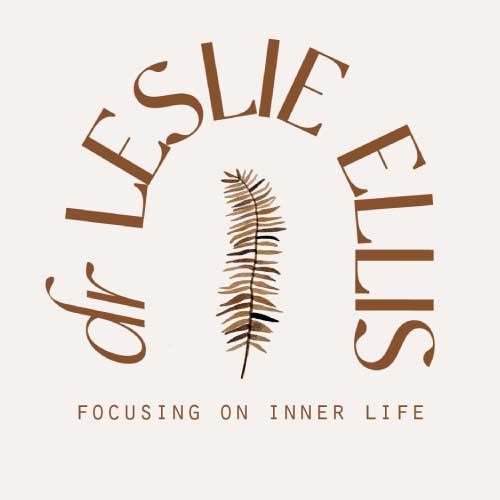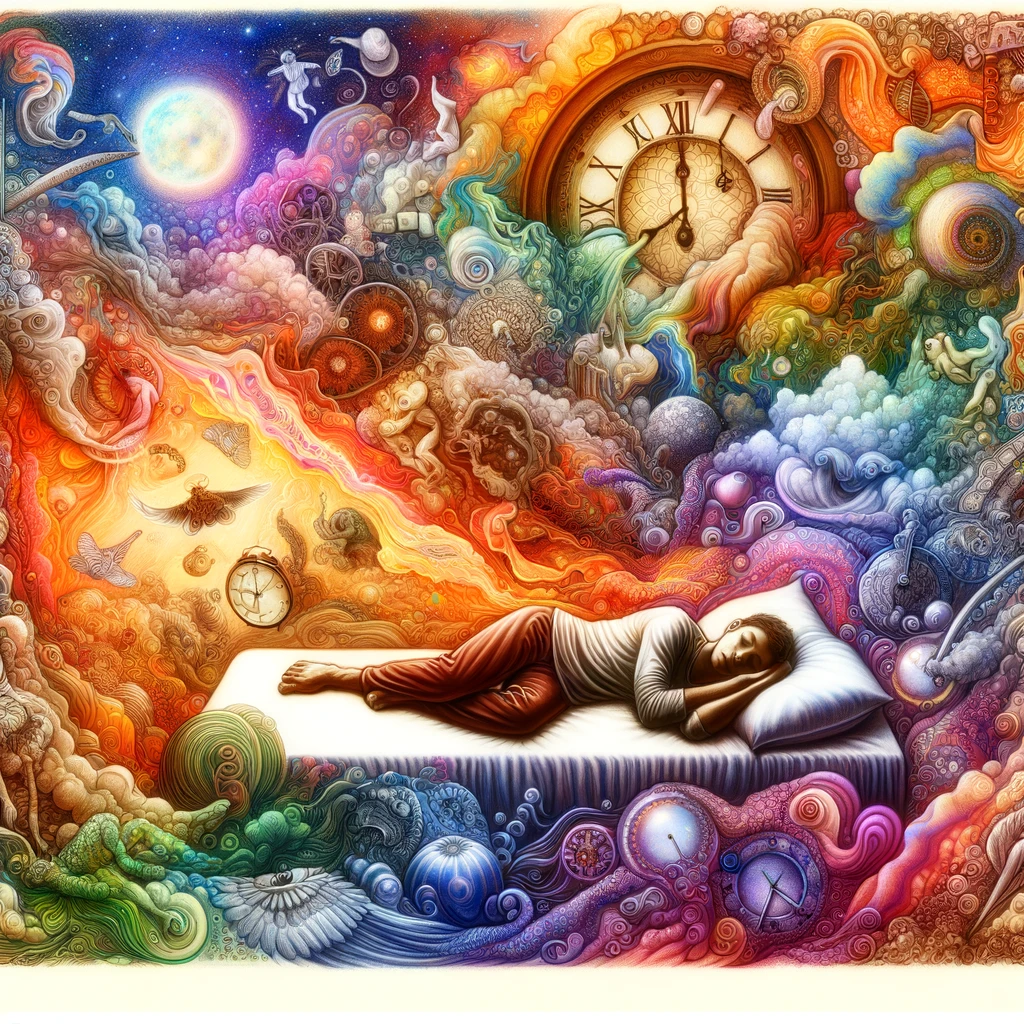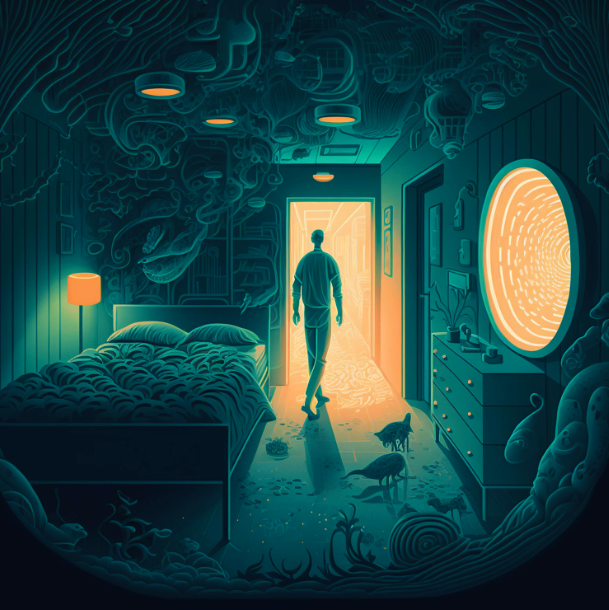This article brings together my two favorite approaches in psychotherapy and personal growth: that of dreamwork and focusing. In my work, they are intertwined in ways that make it difficult to tease apart, so I am taking this opportunity to articulate the way they both differ and complement each other. I will highlight the work of Jungian dream workers who favor experiential processing, and will also summarize Eugene Gendlin’s ideas about how to work with dreams.
The Jungian approach to dreams
Although my interest in dreams is lifelong, I first formally studied dreamwork at Pacifica Graduate Institute, one of North America’s foremost schools for Jungian and depth psychology. While there are some branches of Jungian thought that can get quite theoretical, this is not the approach taken at Pacifica, where they stress the experiential aspects of depth psychology. There are strong parallels between the many dreamwork methods that I consider both Jungian and focusing-oriented. They key to both is the felt experience of the dreamer.
Carl Jung posited that there is not only a personal unconscious from which dream material arises, but also a collective unconscious common to all mankind and that truly numinous dreams have this kind of power. He called these universal forces archetypes, motifs familiar to us all: child, father, mother, lover, wise man/woman and so on.
Jung developed an extensive theory about the meaning of dreams, and believed dream workers should possess vast knowledge of myths, legends and symbols that could appear in any dream so as to amplify the personal aspect of the dream image into something more collective or archetypal. However, it is a mistake to assume that he was imposing all of this onto dreams from an academic pedestal. In fact, he was very interested in the lived experience of dreams, and developed a technique he called active imagination, suggesting that dreamers re-enter the dreamworld and continue where the dream left off, dreaming it onward in the therapy session and beyond. These experiential techniques are very like Gendlin’s focusing, an experiential method of inquiring into the body.
The beauty of dreamwork is that it can take many forms. One can work with a dream on a personal level and make great leaps forward in consciousness. One can also approach the dream in a sacred way that brings one closer to the universal source of dreaming and feel touched by its numinosity. I think the reason dreams are so fascinating is that they are truly magical, truly other and if one enters the experience of the dreaming, one cannot help but be enlarged by it. In fact, many dream experts believe the main purpose of dreaming is just that: to enlarge our perspective; sometimes they do this gently, and sometimes in a shocking manner. At times, a shock can be just what’s needed to jolt us out of outmoded ways of being.
Approaches to dreams from depth psychologists
Jungian scholars whose interest is depth psychology focus on the experience of dreaming; they talk about less mining of the dream for personal insight, and more about tending the dream. They often use focusing extensively in the way they do dreamwork though they may not use that term. In the course of their work, they have developed a reverence for the dreamtime. They ask not, how can the dream serve me, but, how can I serve the dream? What does it ask of me?
James Hillman (1979) in The Dream and the Underworld took issue with the modern method of mining dreams for personal meaning. He is a thinker, a contrarian and likes to turn widely-accepted ideas on their heads. Hillman said he follows Freud and Jung in some of their ideas: “Freud by insisting that the dream has nothing to do with the waking world but is psyche speaking to itself in its own language: and Jung by insisting that the ego requires adjustment to the night world. I shall not be following them in bringing the dream into the dayworld in any other form than its own, implying that the dream may not be envisaged either as a message to be deciphered for the dayworld (Freud) or as a compensation to it (Jung)” (p. 13).
Hillman goes on to say that the only valid way to approach dreaming is to enter into its underworld realm, subjecting ourselves to the descent, not trying to use it for our own purposes. He does not think we need to add anything, or compensate from what’s not there. “Each dream has its own fulcrum and balance, compensates itself, is complete as it is… We cannot see the soul until we experience it, and we cannot understand the dream until we enter it “ (p. 80).
Hillman eschews the gestalt tradition of having dreamers enter into the experience of various dream figures as though they are parts of one’s own psyche. “This mode of dream interpretation becomes just one more modern way of inflating the ego” (p. 99).
Still, entering into the consciousness of various dream figures remains an accepted means of working a dream. Robert Bosnak (1996) is one modern dream worker who relies heavily on this Gestalt method. He says that, “While dreaming, there are several different carriers of consciousness.” We most often experience our dreams from the point of view of our dream ego, but Bosnak believes “one of the purposes of dreamwork is to experience the dream from as many facets as possible.”
He talks about making transits into the experience of other dream figures, to relinquish briefly our habitual point of view and enter into something that is other. In fact, one can enter into not just the people and animals in a dreamscape, but any significant feature. He offers an example of a man who enters into a deep freeze. “This brings about a change of attitude, a different sense of being alive” (p. 54).
Bosnak believes we can work only with living dreams, ones in which we are still able to re-enter the dreaming experience. Fresh dreams can be from years past, but most are recent. They are dreams where we can still sense in a bodily way. Bosnak asks dreamers to go very slowly back into the dream recalling as much detail as possible, paying particular attention to the others in the dream. He suggests you drop down into a liminal state and then enter into the consciousness of the other in your dream through sensing into your body. He calls is making a “transit” (p. 44) into the dream other. This is very similar to the focusing move of entering the felt sense from its point of view.
The attitude is a focusing one of curiosity, acceptance, and a sense that there is autonomy in what we are encountering, something to resonate with, not something we try to bend to our will. Both focusing and dreamwork take place in the imaginal world, the world of image. There is a sense of autonomy about the image, as in working with the felt sense. We can experience it but we do not control its movements.
Pacifica founder Stephen Aizenstat (2009) does believe in talking to the animals and other figures in dreams, but respectfully and only once one has built a relationship to the dream figure. His favorite approach to a dream is the question, “Who’s visiting now?” This, followed by a receptive, clear space in which the dream itself can respond, in the present, in a living, embodied way.
Aizenstat suggests a way of working with dreams beyond the Freudian idea of association, or the Jungian idea of amplification, to that of animation. Aizenstat calls his practice dream tending — working with the living image. Although it is not a felt sense, the interaction with the dream figure has many qualities similar to focusing: the act of bringing your open, curious attention to it. Its autonomy. The need to stay with it even when it might appear scary — that with our loving attention to it, from an observing, safe distance, it will transform, as will what it represents in our life.
Eugene Gendlin on Focusing and Dreams
Gendlin (1986) offers a similar perspective in his approach to working with dreams. Although he posits his methods of dreamwork as a long series of potential questions to ask of the dream, the attitude he suggests one should bring to these questions is not one of interrogation. Like Aizenstat, he suggests that one should “love and enjoy the dream whether you interpret it or not” (p. 27).
He sees great value in dreamwork, and even suggests it is as a shortcut to learning how to do focusing. He says the hardest part of learning how to focusing is letting a felt sense come. “With a dream, that is often easy. A dream usually brings you a felt sense. If not, it soon comes if you attend your body while pondering the dream” (p. 3). Gendlin sees dreamwork as having two stages: the breakthrough, where you discover what the dream is about and a second stage, where you get something new from the dream.
He also introduces a technique he calls bias control to help someone working with their own dreams overcome the natural tendency to interpret a dream based on what one already knows. This basically entails entertaining the opposite of what we might be drawn to, entering into the consciousness of a dream figure we dislike, for example. “A new growth direction is often the opposite of what we value most. That doesn’t mean we change our value to the opposite, not at all. We merely expand them a little” (p. 61).
Completing the dream process: Carrying forward
If you go through the experiential process of fully tending a dream, it will require not just a widening of perspective, but some sort of concrete action or ritual to ground and symbolize the change in you. An even better way to look at it might be: what are you going to offer in response to this dream? These lines of dreamwork practice we have been following ask that we ponder how we will serve the dream, rather than how it will serve us.
In Gendlin’s model, this may come in the form of an action step, some small but concrete step we can take in response to the dream. He gives an example where a man’s “dream points to a small action step he might not otherwise have thought of. This may seem a tiny step when compared with the whole regime this dreamer might need… As you will see if you try them, small action steps have a lot of power. They are hard to do. They let you encounter and work through what is in your way. They change you… Only action ultimately resolves more problems. Therefore action steps are needed as an integral part of what dreams mean… and only in actions does your body get to live the new way for more than a few symbolic moments!” (p. 114).
Dreaming from the Source
Dreams and the felt sense in focusing come from the same source, what Whitmont calls the Guiding Self, or Jung’s Self, a “superior, if archaic intelligence, bent on offering meaningful new attitudes,” (Whitmont Perera, p. 17).
Both focusing and dreamwork are difficult to do alone because of this — because they offer a viewpoint different from our customary one. Dreams are perhaps further from the ego’s standpoint because they often originate from deeper in the unconscious. Or, they may originate entirely outside of our realm of consciousness in a realm all their own. Either way, they are a stretch for us to grapple with. They offer growth potential, but also the potential to be disruptive or disturbing. Focusing is more of a middle ground between dreams and ego, and focusing on dreams is yet another intermediate step, bridging the gap between dream and ego, making dreams more accessible and potentially accelerating change.
Dreams are a product of the life force within us, as is the felt sense we contact through focusing. There are no bad dreams. The question is how to come into relationship with them, as you would a felt sense, to gain ‘life-forward’ momentum. And then, how do you embody this shift in the world?
References
Aizenstat, S. (2009) Dream Tending, New Orleans, Louisiana: Spring Journal Inc.
Boa, F. (1988) The Way of the Dream, Boston, Mass., Shambhala Publications.
Bosnak, R. (1996) Tracks in the Wilderness of Dreaming, New York: Delta Publishing a division of Bantam Doubleday Dell.
Freud, S. (1909) The Interpretation of Dreams, New York: Modern Library, Random House (1950 edition).
Hillman, J. (1979) The Dream and the Underworld, New York: Harper and Row.
Gendlin, E.T. (1986) Let Your Body Interpret Your Dreams, Wilmette, Illinois: Chiron Publications.
Jung, C.J. Collected Works. Bollingen Series, Princeton University Press.
Jung, C.J. (1961) Memories, Dreams, Reflections, New York: Random House.
Whitmont, E. and Perera, S. (1989) Dreams, A Portal to the Source, London: Routledge.










